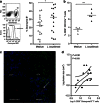CD8(+) granzyme B(+)-mediated tissue injury vs. CD4(+)IFNγ(+)-mediated parasite killing in human cutaneous leishmaniasis
- PMID: 23321919
- PMCID: PMC3667352
- DOI: 10.1038/jid.2013.4
CD8(+) granzyme B(+)-mediated tissue injury vs. CD4(+)IFNγ(+)-mediated parasite killing in human cutaneous leishmaniasis
Erratum in
- J Invest Dermatol. 2014 Nov;134(11):2850
Abstract
A protective or deleterious role of CD8(+)T cells in human cutaneous leishmaniasis (CL) has been debated. The present report explores the participation of CD8(+)T cells in disease pathogenesis as well as in parasite killing. CD8(+)T cells accumulated in CL lesions as suggested by a higher frequency of CD8(+)CD45RO(+)T cells and CD8(+)CLA(+)T cells compared with peripheral blood mononuclear cells. Upon Leishmania braziliensis restimulation, most of the CD8(+)T cells from the lesion expressed cytolytic markers, CD107a and granzyme B. Granzyme B expression in CL lesions positively correlated with lesion size and percentage of TUNEL-positive cells. We also observed a significantly higher percentage of TUNEL-positive cells and granzyme B expression in the biopsies of patients showing a more intense necrotic process. Furthermore, coculture of infected macrophages and CD8(+)T lymphocytes resulted in the release of granzyme B, and the use of granzyme B inhibitor, as well as z-VAD, Fas:Fc, or anti-IFN-γ, had no effect upon parasite killing. However, coculture of infected macrophages with CD4(+)T cells strongly increased parasite killing, which was completely reversed by anti-IFN-γ. Our results reveal a dichotomy in human CL: CD8(+) granzyme B(+)T cells mediate tissue injury, whereas CD4(+)IFN-γ(+)T cells mediate parasite killing.
Figures





References
-
- Akdis M, Simon HU, Weigl L, et al. Skin homing (cutaneous lymphocyte-associated antigen-positive) CD8+ T cells respond to superantigen and contribute to eosinophilia and IgE production in atopic dermatitis. J Immunol. 1999;163:466–475. - PubMed
-
- Antonelli LR, Dutra WO, Almeida RP, et al. Activated inflammatory T cells correlate with lesion size in human cutaneous leishmaniasis. Immunol Lett. 2005;101:226–230. - PubMed
-
- Barral-Netto M, Barral A, Brodskyn C, et al. Cytotoxicity in human mucosal and cutaneous leishmaniasis. Parasite Immunol. 1995;17:21–28. - PubMed
-
- Betts MR, Brenchley JM, Price DA, et al. Sensitive and viable identification of antigen-specific CD8+ T cells by a flow cytometric assay for degranulation. J Immunol Methods. 2003;281:65–78. - PubMed
Publication types
MeSH terms
Substances
LinkOut - more resources
Full Text Sources
Other Literature Sources
Research Materials
Miscellaneous

